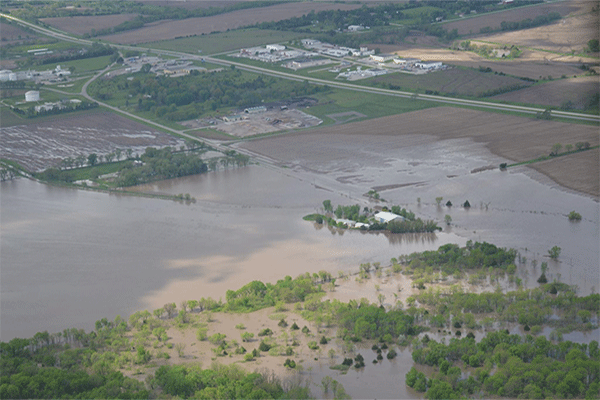Over the past month, images of the flooding associated with Hurricanes Harvey, Irma and Maria have shown the power water can have on people, property and the landscape. The historic and catastrophic storms have left more than a billion dollars in damage in its wake and will have forever reshaped the natural and built environment in southeast Texas, Florida and Puerto Rico.
The extreme flooding also resulted in thousands of people losing access to safe drinking water and exposure to floodwaters containing untreated wastewater. Impacts to water systems and water quality are often not as visible as the damage to property or the landscape. Additionally, rainfall does not have to be on the level of those from a storm like Hurricane Harvey, Irma, or Maria to result in flooding or stormwater runoff that can pose serious risks to water systems and human health.
Nebraska is fortunately not subject to the devastating impacts of hurricanes. However, heavy rains are common to Nebraska and can produce high volumes of stormwater runoff, flash flooding or floods from swollen creeks, rivers and reservoirs that can persist over days, weeks or even months.
The likelihood of flooding or frequent occurrence of significant stormwater runoff is generally higher in eastern Nebraska because of higher average rainfalls, heavier clay soils that are not able to absorb rainfall very quickly, as well as, larger river systems and a corresponding higher number of smaller contributing watersheds. Those natural characteristics combined with the higher population of people residing in Eastern Nebraska, means there are more people with a higher potential to experience impacts from floods and stormwater runoff.
Floodwater and Stormwater Runoff Hazards to Drinking Water
Floods are high volumes of water flow over areas that are normally dry land. They affect houses, infrastructure, businesses, farmland and other areas where chemicals, fuel, bacteria and other potential pollutants harmful to human health and the environment may be located. Those contaminants travel with the floodwater, often in very high volume, as it courses over and accumulates across the landscape.
The result is a significant and serious risk to essentially anyone or anything the floodwater has contacted, including individual drinking water wells or community water systems. Floodwaters can fully inundate water wells for days or weeks. The force of floodwaters can also disrupt or damage well or water supply infrastructure and directly introduce the contaminated water into the well.
Stormwater runoff is water from rain or melting snow and ice that does not soak into the ground. Stormwater can be thought of simply as rainwater or snow melt that leaves a downspout on a house, runs down the driveway or across the yard and is far more common than floods. In urban areas where paved surfaces are more common, stormwater can accumulate in larger volumes and travel more quickly than in suburban or rural areas such as acreages or farmsteads.
Regardless of where stormwater runoff occurs, like floods, it can carry with it harmful contaminants such as soil, animal waste, salt, pesticides, and oil which can potentially impact drinking water wells and water quality. Contaminant-laden runoff can enter drinking water wells through well casings or caps that may not be completely water tight or through infiltration into more shallow groundwater resources. Runoff is less likely to introduce contaminants into deep wells that have been properly constructed, sealed and maintained. However, any potential introduction of contaminants into the well, can pose at least a short-term risk to water quality and human health.
Testing, Treatment and Mitigation
If an individual drinking water well is impacted by a flood, it is critical to stay away from the well while flood waters are present to prevent potential electrical shock from the pump. It is also critical that the water is not used for drinking, washing dishes or clothes or bathing to avoid the potential to become sick or have a topical reaction. Bottled water should be used or the water should be boiled prior to use.
A certified water well professional should assist with cleaning the pump, flushing and disinfecting the well. They should also perform any other maintenance needed to ensure the well is operating properly. The water should be tested for potential contaminants prior to resuming using the water.
Stormwater runoff, unlike floods, can be more easily and consistently managed to protect drinking water wells. A good practice is to take a moment to watch how stormwater runoff flows away from a home or across a driveway or yard during and immediately after rains. If it is running into the vicinity of a well or is accumulating near the well it needs to be redirected to prevent it from entering the area.
Some easy and largely cost-effective methods to better manage or redirect runoff include:
- changing the length or direction of your downspouts,
- installing a rain barrel to collect rainwater for reuse,
- use gravel, pavers or rock for walkways instead of concrete, and
- adding mulch or different types of grasses or landscaping can help slow, retain or redirect stormwater runoff.
Pollutants available for runoff to “grab” and carry along can be reduced by:
- applying pesticides or fertilizers according to label directions and not within 24-hours of forecasted rain,
- preventing oils or other automotive fluids from being dumped on the ground,
- sweeping grass clippings and other yard wastes off paved surfaces and away from runoff routes, and
- removing pet waste from the yard.
Preventing potential impact from stormwater runoff also includes inspecting the well regularly to identify any cracks in the cap or casing. If runoff has pooled near the well over time or if any cracks are noticed, a water quality test should be performed to ensure the water is free of potentially harmful contaminants.

